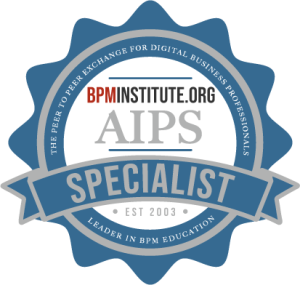Home / Resources
Resources
Discover a Wealth of BPM Knowledge and Expertise at BPMInstitute.org!
Build your SOA: Process and Methodology, Part I
Introduction
SOA projects tend to be large initiatives with a lot of risk and potential reward associated with them. The Return on Investment (ROI) on a SOA project is sometimes very hard to quantify (and thus hard to sell), which brings about the need for a solid process and methodology to ensure the success of an SOA project.
A SOA is a set of tools, technologies, frameworks, and best practices that enable the quick and easy implementation of services.
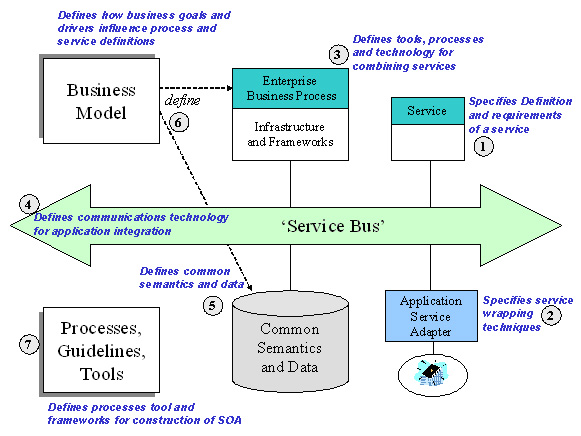
Key Components of SOA
I’m excited to be joining the team of contributors to the SOA Institute. In my first article, I’ll provide my definition of SOA and describe what I think are the key components of an SOA. You will see that I take an enterprise view of SOA.
The Compliance Journey – Balancing Risk and Controls with Business Improvement
Vince Sumpter has over 20 years of experience in Performance Management, data warehousing, and related areas and sees a synergy between process management, performance management, and controls transformation. The new regulatory environment demands compliance, but most of the present efforts are manual and specific only to the rules with little regard to how the changes could improve the business. Sumpter sees process, performance, and controls all coming together to give new value to the enterprise.
Sumpter says there is a lot of buzz now about Sarbanes Oxley (S-O).

BPMS Watch: Standardizing Management of Process Performance
I recently attended an event where experienced BPM vendors, analysts, academics, and user organizations came to discuss what needs to come next in terms of technical standards, software capabilities, and overall business value from business process technology. The event was hosted by OMG, the standards organization behind the Business Process Modeling Notation standard used for process modeling and, increasingly, for business-driven process design.

Doing Business Architecture
It is hard for your organization to have an agile organization these days if your IT systems and infrastructure aren’t. Enterprise Architecture and specifically Business Architecture is aimed at helping organizations become truly agile.
A couple of years ago I wrote an article entitled “The 3 faces of Enterprise Architecture”.

BPM is Art as Well as Science
The release of the Academy Award nominations last January might seem to have little to do with business process management. But it does. In many ways, movies are the quintessential process industry.
Changing Perceptions – How EII Missed the Boat on SOA
In the technology world, there is a lot to be said about perception, and how perception defines your reality. You can perceive a market one way, only to change your point of view slightly and realize that the real target market for a class of technologies is quite different from where those technologies are actually being sold. Unfortunately, that change of perception often occurs too late to make a difference. A perfect example of this phenomenon is Enterprise Information Integration, or EII. EII is a specific segment of the data integration market that was gaining some re
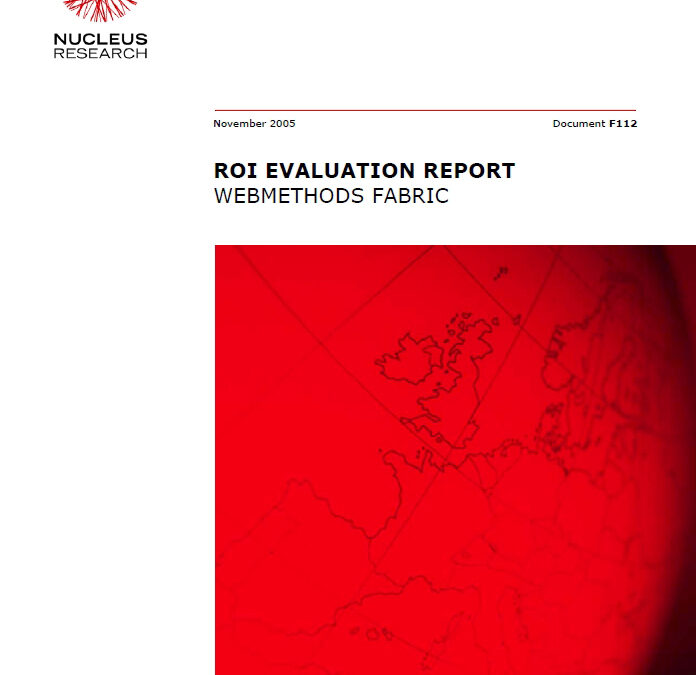
Nucleus Research Report – webMethods Delivers Real SOA ROI through webMethods Fabric
Want Examples of Real Results with SOA? Read On.
Adopting a service-oriented architecture (SOA) enables companies to shorten IT project cycles, improve IT agility, and better align their IT practices with overall company strategy while gaining the tactical returns from integration.
Nucleus Research found customers adopting webMethods Fabric
to support an SOA strategy were able to leverage IT alignment and agility to increase market share, build strategic partnerships, increase revenues, and improve customer service.
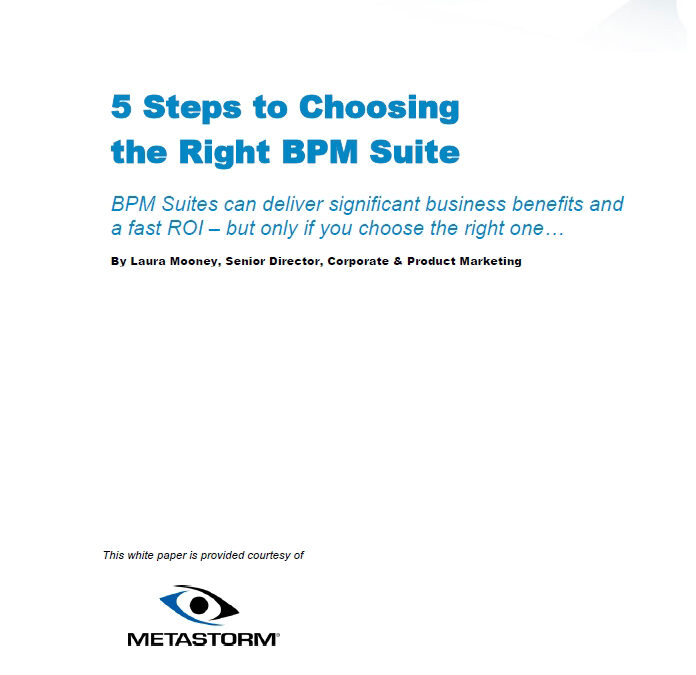
5 Steps to Choosing the Right BPM Suite
BPM Suites can deliver significant business benefits and a fast ROI – but only if you choose the right one. Implementing a complete BPM Suite, rather than a series of disparate applications, will significantly decrease your costs, increase your time to benefit, and increase your flexibility and agility in managing and improving multiple processes. This paper outlines 5 best practice steps to help you choose the right BPM Suite for your organization.

Is RETE Necessary for Business Rules – Why you should care
Many BRMS vendors, especially the leaders Fair Isaac and ILOG, consider their implementation of the RETE algorithm a critical part of their product offering. Yet you might not understand what RETE is and why it can be either useful or unnecessary, depending on the rules problem domain. So what is RETE?
The RETE algorithm was developed to improve evaluation performance with large knowledge or fact sets. For example, a diagnostic expert system might describe many signs and symptoms for the diagnosis of a condition. Because of the diagnosis, an action may be taken.
Analysis: Isn’t that for smart people?
“Analysis is the difficult part of a business improvement project”. “Analysts are really smart people that are hyper intelligent” and “analysis can not be trained”. Those are some of the preconceptions project teams have to fear the analysis work that needs to be done on a process improvement project.
None of these are true. First of all many people confuse analysis with all those complex statistical tools that, for example, six sigma makes you believe you should apply.

Are All Rules Business Rules?
The Business Rules movement has begun the transition from being a niche approach to entering the mainstream of organizations’ project techniques. Where once organizations saw only business processes and requirements, they now also see business rules. In fact, it’s tempting to see everything as business rules. In the midst of the movement’s first encounter with fame and fortune, it’s a good time to ask what the real value proposition is for business rules and whether everything that is potentially a rule should be treated as a business rule.
Is Your Business Process Model Earning Its Keep?
Sandra Lusk has over 20 years experience in systems design and development working with utility, transportation, logistics, insurance and banking organizations in the US, Canada, Australia, New Zealand and Wales. She is also a certified Project Management Professional (PMP) and is currently President of the Association for Business Process Management Professionals for the Portland Chapter.
Lusk says a process model is a vehicle for understanding how things work.
SOA’s New Rules
Remember the “eight second” rule. Back when Internet transactions were new, consumers attempting to purchase goods and services online were stymied by poor website performance. Service outages and brownouts occurred seemingly at random with no connection to the high availability of the underlying systems. Business managers lived in fear of service outages becoming news stories and crashing high-flying stock prices.
The issue was lack of visibility. Management systems only monitored specific parts of the infrastructure making up the tiered web applications.
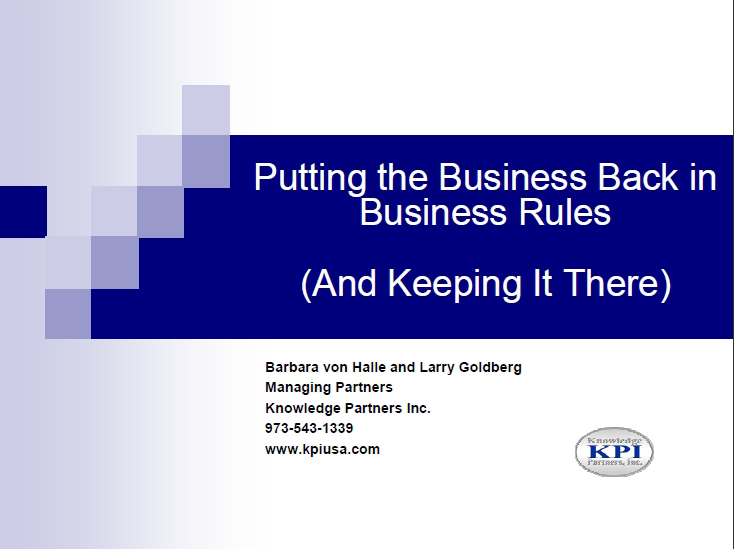
Putting the Business Back in ‘Business Rules’ (and keeping it there) Part 1
An enterprise pursues its mission by the formulation of policy, and these policies are implemented by rules that permeate the business. But where are these rules kept, and how do they relate to the policies that supposedly gave them birth? Typically they are buried in documents, peoples minds, policy manuals, and most frequently in business system software code. And not only is their existence forgotten – but there very purpose lies buried under strata of system changes and evolutions.

Asking and Answering the Right Questions About Certification
“Most certification today is pure ‘credentialism.’ It must begin to reflect our demand for excellence, not our appreciation of parchment.”
-William John Bennet
As president of ABPMP, I am often asked for my opinion about “certification” programs.
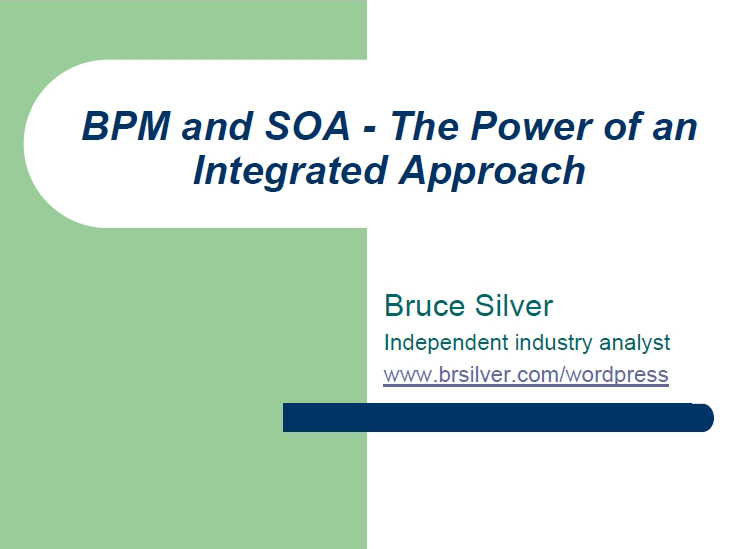
BPM and SOA – The Power of an Integrated Approach
Join this webMethods Webinar as well-known BPM industry expert Dr. Bruce Silver discusses the intersection points between BPM and SOA and the advantages that a solution which integrates the two technologies into a single cohesive platform has over standalone products. Along with Bruce, webMethods VP of Product Development, Pete Carlson describes how the webMethods Fabric suite makes integrated BPM and SOA a reality.
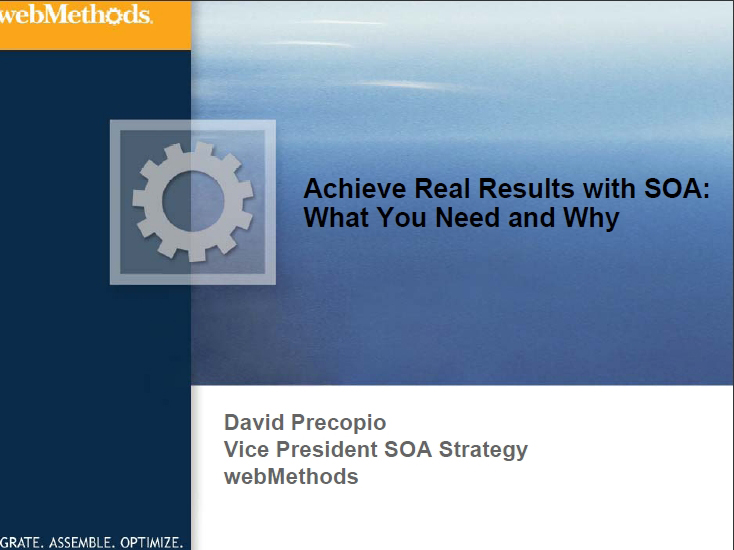
Get Real with SOA – The Technology – What You Need and Why
Although industry standards exist around Web services, there are no standards around the technology capabilities needed to achieve success with SOA or how and when to implement them.
Although industry standards exist around Web services, there are no standards around the technology capabilities needed to achieve success with SOA or how and when to implement them. Join webMethods to learn what’s needed to deliver and support enterprise-class service-oriented business applications and how webMethods Fabric 6.5 enables organizations to achieve real results.
Case Study: Service Based Process Architecture
Linda Gurgone is the Lead Business Process Architect in Motorola’s Enterprise Architecture team.

The Role of SOA in Business / IT Architecture Alignment
Organizations have two universes in constant flux; business architectures and IT architectures. Now a third factor has entered the mix – services oriented architecture (SOA). As organizations seek to align business and IT architectures, SOA can play a key role in streamlining this process. This article discusses how SOA helps align business and IT architectures to deliver more effective, more efficient responses to ongoing business demands – on a transitional basis and over the long-term.










